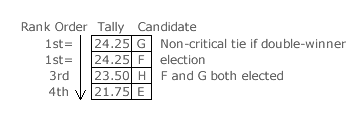Description: Outcomes
Ranked Ballot



Having determined the tally for each candidate, it only remains to rank order the candidates from most to least preferred according to these tallies. Continuing the example election from the previous page, the overall rank order of the four candidates is given in the table opposite.
No mention has been made so far in this election as to how many candidates are to be elected since it is irrelevant up to this point. In general, most ranked ballot elections are used to elect a single winner. Where this is the case, the most preferred or top-ranked candidate clearly wins. If two, three or more winners are needed then the two, three or more top-ranked candidates all win. GV/CHPV is therefore not only applicable to single-winner elections but also to ones with several winners. GV/CHPV is a system that ranks all candidates rather than one that just differentiates winners from losers.
As CHPV tallies should always be 100% accurate, false ties should never occur. Nevertheless, genuine ties will inevitably result when two or more candidates have identical tallies. A tie between two or more winners or a tie between two or more losers does not need to be resolved. Hence they are called non-critical ties. A tie amongst two or more candidates where at least one winner must be elected and at least one loser rejected is called a critical tie. Such critical ties must be resolved by random selection or by some other pre-declared fair method. [One such alternative method is discussed in the later Comparisons: Plurality Rule Methods section.] The middle example opposite illustrates a critical tie. An example of a non-critical tie is shown below it.
In some preferential voting systems, notably those where votes are transferred, ties may occur during the count process itself and they then have to be resolved via random selection before the next stage of the count can proceed. Clearly, the resultant rank order can vary if accurate reruns of the count are required (with the voter input unchanged) as the intermediate random choice should differ on some occasions if it is indeed truly random. Such systems are said to employ an indeterminate algorithm as the results are not consistently repeatable. CHPV never involves any intermediate random selection and will always generate the same collective rank order after any accurate recount. CHPV hence has a deterministic algorithm and always yields reliable and repeatable results.
Critical ties are particularly important in analysing and evaluating GV/CHPV and in comparisons with other systems. Such ties represent the thresholds or boundary conditions between different election outcomes. It is by comparing these boundaries that the distinguishing features of any two rival voting systems emerge. Such analysis is covered in the following Evaluations and Comparisons chapters.
Proceed to next section > Description: Party-List
Return to previous page > Description: Counting
